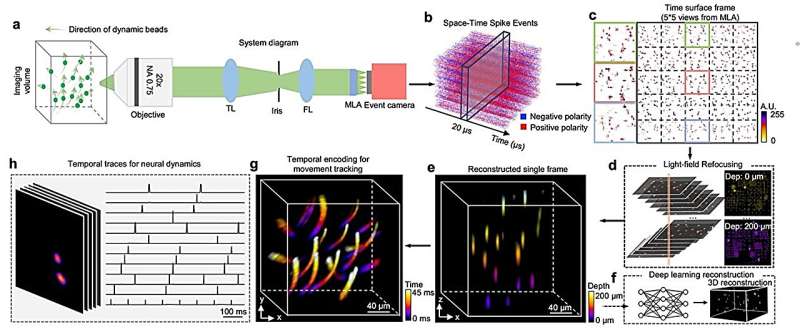This article has been reviewed according to Science X's editorial process and policies. Editors have highlighted the following attributes while ensuring the content's credibility:
fact-checked
peer-reviewed publication
proofread
Event camera integrates Fourier light field microscopy for ultrafast 3D imaging

High-speed volumetric imaging is an indispensable tool for investigating dynamic biological processes. Traditional scanning-based 3D imaging techniques, such as confocal microscopy, two-photon microscopy, and light-sheet microscopy offer high spatial resolution.
However, their data acquisition speeds are constrained by the need for beam scanning, suffering from an inherent trade-off between temporal resolution and the space-bandwidth product (SBP), measured by the ratio of the 3D field-of-view (FOV) to the spatial resolution.
By recording the light field information at the Fourier domain, Fourier light field microscopy (LFM) achieves a consistently high spatial resolution across the recovered volume. Yet, the synchronous readout constraints of traditional CMOS cameras pose a bottleneck, limiting existing single-shot 3D wide-field techniques to under 100 Hz at full-frame resolution.
This constraint hinders their applications in capturing ultrafast dynamic biological processes that may exceed kilohertz (kHz), such as voltage signals in mammalian brains, blood flow dynamics, and muscle tissue contraction, thus leaving a significant technological gap yet to be bridged.
In a new paper published in Light: Science & Applications, a team led by Professor Lei Tian from the Department of Electrical and Computer Engineering at Boston University, and co-workers have developed an EventLFM, a novel ultrafast, single-shot 3D imaging technique that integrates an event camera into a Fourier LFM system to facilitate volumetric imaging at kHz speeds.
The team demonstrated EventLFM's capability to reconstruct complex dynamics of rapidly moving 3D objects at 1 kHz temporal resolution. Through controlled illumination experiments, they showcased its ability to image high-frequency 3D blinking objects with pulse widths as short as 1 ms.
Additionally, the technique effectively captures rapid dynamic signals within scattering tissues, as evidenced by imaging realistic neuronal activities in a mouse brain section simulated by a series of DMD patterns to induce unique spatiotemporal footprints at kHz rates.
The team also presented successful imaging and tracking of GFP-expressing neurons in freely moving C. elegans within a 3D space, achieving a frame rate of 500 Hz. The integration of a deep learning reconstruction network with EventLFM has significantly improved imaging quality and enhanced 3D resolution.
This reported work provides researchers with a new tool to observe 3D dynamic biological processes at kilohertz speeds.
"We designed EventLFM to integrate an event camera with a Fourier LFM system, enabling the imaging of complex, rapid biological processes at kilohertz rates with high 3D resolution," said the researchers.
"It should be noted that the kilohertz frame rate demonstrated in our experimental results is determined by the accumulation time, which can be adjusted in the post-processing step without affecting the data capture speed. By reducing the accumulation time further, we can enhance the system's capability to capture dynamic processes beyond kilohertz rates," they added.
"We highlight EventLFM's capability to image blinking neuronal signals in scattering mouse brain tissues and to track GFP-labeled neurons in freely moving C. elegans. Given its simplicity, ultrafast 3D imaging capability, and robustness in scattering environments, EventLFM has the potential to be a valuable tool in various biomedical applications for visualizing complex, dynamic 3D biological phenomena," the scientists forecast.
More information: Ruipeng Guo et al, EventLFM: event camera integrated Fourier light field microscopy for ultrafast 3D imaging, Light: Science & Applications (2024). DOI: 10.1038/s41377-024-01502-5
Journal information: Light: Science & Applications
Provided by TranSpread



















